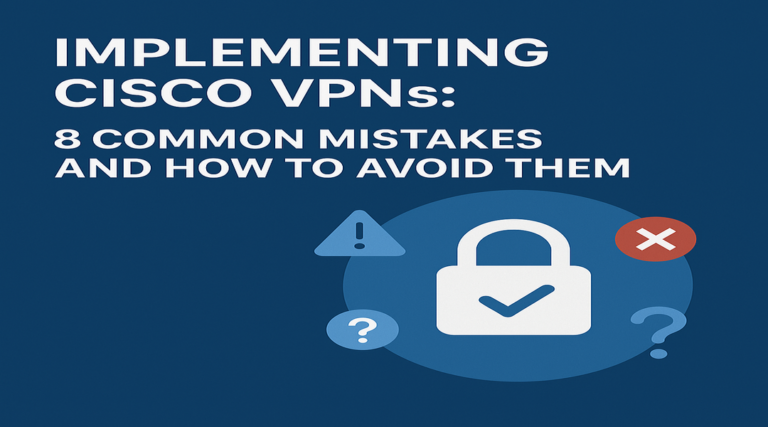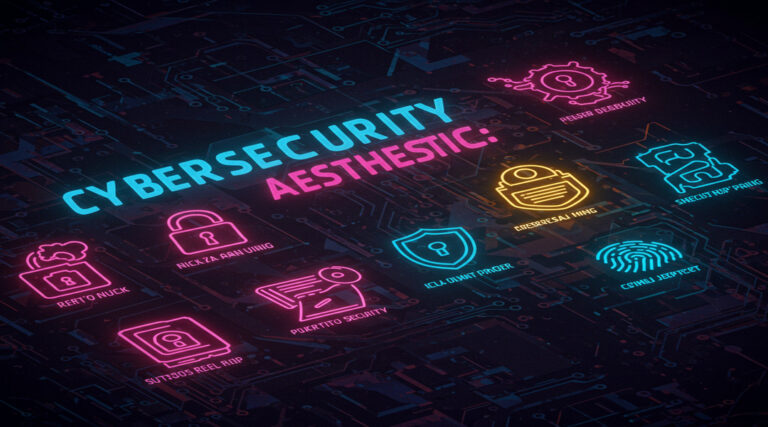Network Security: 5 Must-Know Tips for Beginners
In today’s hyperconnected world, network security has transitioned from a luxury to an absolute necessity. With over 4,100 publicly disclosed data breaches in 2023 alone exposing more than 22 billion records, organizations of all sizes find themselves in the crosshairs of increasingly sophisticated cybercriminals. The 2023 Colonial Pipeline ransomware attack serves as a sobering reminder of how vulnerable even critical infrastructure can be, resulting in fuel shortages across the eastern United States and a $4.4 million ransom payment.
For businesses, the stakes couldn’t be higher. Beyond immediate financial losses averaging $4.35 million per data breach, companies face devastating reputational damage, regulatory penalties, and potential legal liabilities. For individuals, compromised personal data can lead to identity theft, financial fraud, and years of remediation efforts.
The good news? With the right knowledge and tools, you can significantly reduce your vulnerability to these threats. Whether you’re an IT professional, a small business owner, or simply someone looking to protect their digital assets, implementing robust network security measures is more accessible than you might think. Let’s explore the essential strategies that can help safeguard your digital world against the evolving landscape of cyber threats.
Table of Contents
What is Network Security?
Network security encompasses all activities designed to protect the usability and integrity of your network and data. It combines hardware, software, and human elements to create a comprehensive shield against unauthorized access, misuse, modification, or denial of your computer network and resources.
Think of network security as the digital equivalent of your home’s security system—it includes the locks on your doors (firewalls), alarm systems (intrusion detection), security cameras (monitoring tools), and trained guards (security protocols). Just as you wouldn’t leave your front door unlocked in a high-crime area, you shouldn’t leave your network vulnerable in today’s threat-rich digital environment.
Whether you’re a small business owner or an IT professional, understanding network security fundamentals is your first step toward building a resilient digital infrastructure. Let’s dive deeper into why this matters so much.
Why You Need Network Security
1. Protection Against Cyber Threats
Today’s cyber landscape is teeming with sophisticated threats designed to exploit network vulnerabilities. Ransomware attacks have increased by 150% in the past year, with an attack occurring approximately every 11 seconds. These attacks can encrypt critical data and demand substantial ransoms for its release.
Meanwhile, phishing attempts have grown in sophistication, with attackers crafting increasingly convincing emails that can fool even security-conscious users. DDoS attacks continue to overwhelm networks, with the largest recorded attack reaching a staggering 2.4 Tbps.
Without proper network security, these threats can infiltrate your systems, compromise sensitive data, disrupt operations, and damage your reputation. The 2021 SolarWinds attack demonstrated how even sophisticated organizations can fall victim when network security is compromised.
2. Financial and Data Security Benefits
Investing in network security isn’t just about preventing disasters—it’s a sound financial decision. The average cost of a data breach has reached $4.35 million, while the global average cost of cybercrime is projected to reach $10.5 trillion annually by 2025.
Beyond immediate financial losses, network breaches can expose sensitive customer information, intellectual property, and proprietary business data. For healthcare organizations, patient records can be compromised. For financial institutions, customer financial data becomes vulnerable.
Implementing robust network security is significantly less expensive than recovering from a breach. While security investments might represent 10-15% of an IT budget, breach recovery costs can devastate an entire organization, with 60% of small businesses closing within six months of a major cyber attack.
3. Compliance with Security Regulations
Today’s regulatory environment demands stringent security measures across industries. The General Data Protection Regulation (GDPR) imposes fines of up to €20 million or 4% of global annual revenue for non-compliance. Meanwhile, HIPAA violations in healthcare can result in penalties of up to $1.5 million per violation category per year.
Other regulations like PCI DSS for businesses handling credit card information, SOX for publicly traded companies, and industry-specific frameworks all require robust network security measures. Failure to comply not only increases breach risks but also exposes organizations to significant legal and financial penalties.
Proactive network security implementation ensures compliance while protecting your organization’s most valuable assets—its data and reputation.
How to Implement Network Security
Quick Overview
A strong network security system combines multiple layers of defense. At its core are properly configured firewalls that act as gatekeepers, strong encryption that protects data both in transit and at rest, and robust authentication protocols that verify user identities.
Equally important are regular software updates to patch vulnerabilities, continuous monitoring to detect suspicious activities, and comprehensive employee awareness training. Research shows that human error contributes to 95% of cybersecurity breaches, making security education an essential component of any protection strategy.
Key Components of Network Security
1. Firewalls
Firewalls serve as the first line of defense, monitoring and filtering incoming and outgoing network traffic based on predetermined security rules. Next-generation firewalls (NGFWs) provide advanced threat detection, application awareness, and integrated intrusion prevention capabilities, offering protection against sophisticated attacks that traditional firewalls might miss.
2. Intrusion Detection and Prevention Systems (IDPS)
IDPS solutions continuously monitor network traffic for suspicious activities and known attack patterns. Once detected, these systems can automatically block malicious traffic, isolate affected systems, and alert security teams. Modern IDPS solutions use behavioral analysis and machine learning to identify even previously unknown threats.
3. Virtual Private Networks (VPNs)
VPNs create encrypted tunnels for secure communications across public networks, essential for remote work security. They mask IP addresses and encrypt data transmissions, preventing eavesdropping and man-in-the-middle attacks while enabling secure access to corporate resources from any location.
4. Endpoint Security Solutions
With the proliferation of devices connecting to networks, endpoint security has become critical. These solutions protect individual devices from malware, detect suspicious behaviors, and enforce security policies. Modern endpoint protection platforms (EPPs) combine antivirus, anti-malware, data encryption, and personal firewalls.
5. Multi-Factor Authentication (MFA)
MFA requires users to provide two or more verification factors to gain access, dramatically reducing unauthorized access risks. By combining something you know (password), something you have (security token), and something you are (biometric verification), MFA creates multiple security layers that are difficult for attackers to overcome.
6. Data Encryption
Encryption transforms readable data into coded text that can only be deciphered with the correct encryption key. This protects sensitive information both in transit and at rest. Modern encryption standards like AES-256 make data practically impossible to decrypt without proper authorization.
7. Security Information and Event Management (SIEM)
SIEM systems aggregate and analyze security data from multiple sources across your network. By correlating events and identifying patterns, SIEM solutions help detect threats that might otherwise go unnoticed, enabling faster response to security incidents.
Step-by-Step Guide to Strengthening Network Security
- Conduct a comprehensive security assessment: Begin by identifying all assets, mapping your network, and documenting existing security controls. Use vulnerability scanning tools to identify weaknesses and prioritize remediation efforts based on risk levels.
- Develop a security policy framework: Create clear policies covering acceptable use, access control, password management, and incident response. Ensure these policies align with your business objectives and compliance requirements.
- Implement layered security controls: Deploy firewalls at network boundaries, segment your network to isolate sensitive systems, implement IDPS to detect threats, and use endpoint protection on all devices connecting to your network.
- Secure authentication systems: Require strong, unique passwords for all accounts and implement MFA wherever possible. Use centralized identity management to streamline access control and quickly revoke privileges when needed.
- Encrypt sensitive data: Identify all sensitive information and implement appropriate encryption methods. Use TLS/SSL for data in transit and file/disk encryption for data at rest.
- Establish continuous monitoring: Deploy SIEM solutions to aggregate and analyze security events, establish baseline network behavior to identify anomalies, and create alerts for suspicious activities.
- Develop and test incident response plans: Create detailed procedures for different types of security incidents, assign specific roles and responsibilities, and conduct regular drills to ensure readiness.
- Provide security awareness training: Develop comprehensive training programs for all employees, conduct regular phishing simulations, and create a security-conscious culture throughout your organization.
What to Combine Network Security With
For truly robust protection, network security should be part of a broader cybersecurity strategy that includes:
Cloud Security Solutions
As organizations increasingly migrate to cloud environments, specialized security measures become essential. Implement cloud access security brokers (CASBs), cloud workload protection platforms (CWPPs), and cloud security posture management (CSPM) to protect data and applications across multi-cloud environments.
Zero Trust Architecture
Moving beyond the traditional “trust but verify” approach, zero trust adopts a “never trust, always verify” stance. This architecture requires strict identity verification for every person and device trying to access resources, regardless of whether they’re inside or outside the network perimeter.
AI-Powered Threat Detection Systems
Machine learning and artificial intelligence can analyze vast amounts of data to identify patterns and anomalies that might indicate attacks. These systems continuously improve their detection capabilities by learning from new threat data, providing protection against evolving threats.
Cyber Hygiene Training for Employees
Since human error remains a leading cause of security breaches, comprehensive training programs are essential. Regular simulations, clear security guidelines, and creating a culture of security awareness can dramatically reduce your vulnerability to social engineering attacks.
Top Tips for Strengthening Network Security
1. Implement Password Management Best Practices
Move beyond basic password complexity requirements by implementing password managers that generate and store unique, complex passwords for each service. Combine this with MFA and single sign-on (SSO) for both security and usability.
2. Configure Firewalls and VPNs Correctly
Default configurations rarely provide optimal security. Take time to properly configure firewalls with appropriate rule sets that follow the principle of least privilege. For VPNs, use strong encryption protocols (like OpenVPN or IKEv2), implement split tunneling carefully, and regularly audit VPN access.
3. Conduct Regular Penetration Testing
Don’t wait for attackers to find your vulnerabilities. Regular penetration testing by qualified security professionals can identify weaknesses before they’re exploited. Combine this with continuous vulnerability scanning to address new issues as they emerge.
4. Avoid Common Security Mistakes
Prevent the most frequent security errors: neglecting patches and updates, using outdated security solutions, failing to segment networks, overlooking IoT device security, and relying solely on perimeter defenses instead of adopting defense-in-depth strategies.
5. Store and Manage Security Logs Effectively
Security logs provide crucial evidence during incidents and help identify emerging threats. Implement centralized log management with appropriate retention periods, ensure logs are tamper-resistant, and establish regular review processes. SIEM solutions can automate log analysis, correlating events across systems to identify attack patterns that might otherwise go unnoticed.
Frequently Asked Questions
What is the best firewall for small business?
For small businesses, next-generation firewalls (NGFWs) like Fortinet FortiGate, Cisco Meraki, or Sophos XG provide excellent protection with user-friendly interfaces. The ideal solution depends on your specific needs, budget, and existing infrastructure. Look for solutions offering integrated security features, cloud management, and scalability to grow with your business.
How is network information security different from cybersecurity?
Network information security specifically focuses on protecting data as it travels across networks and resides on networked devices. It’s a subset of the broader cybersecurity field, which encompasses all aspects of information protection including application security, identity management, and physical security. Effective cybersecurity strategies always include robust network security measures.
What should I look for in network security companies?
When evaluating network security companies, prioritize those with proven experience in your industry, comprehensive service offerings (from assessment to implementation and monitoring), strong customer support, and transparent pricing. Request case studies, check references, and ensure they stay current with emerging threats and technologies.
How often should network penetration testing be performed?
Most organizations should conduct penetration testing annually at minimum. However, testing should also occur after significant infrastructure changes, major application deployments, or office relocations. Regulated industries may require more frequent testing to maintain compliance, while organizations with high-value assets might benefit from quarterly assessments.
What are the essential components of network security monitoring?
Effective network security monitoring combines several elements: continuous traffic analysis, behavioral anomaly detection, comprehensive log management, automated alert systems, and vulnerability scanning. Organizations should implement tools that provide visibility across the entire network while filtering alerts to prevent security team fatigue.
How do I choose between different network security providers?
Select providers based on your specific requirements, including industry expertise, service levels, technical capabilities, and budget constraints. Request detailed proposals covering threat detection capabilities, response procedures, reporting methods, and escalation protocols. Consider providers offering flexible solutions that can adapt as your security needs evolve.
What are the most cost-effective network security solutions for startups?
Startups should focus on fundamental security controls that provide maximum protection for minimal investment: cloud-based firewalls with unified threat management capabilities, endpoint protection platforms, secure Wi-Fi configurations, and employee security awareness training. As resources permit, add more advanced solutions like SIEM and dedicated security monitoring.
How does cloud security network differ from traditional network security?
Cloud security requires different approaches due to shared responsibility models, distributed architectures, and unique access patterns. While traditional network security focuses on perimeter defenses, cloud security emphasizes identity management, data protection, and service configuration. Cloud environments typically require specialized tools like CASBs and cloud-native security platforms.
What’s the relationship between cyber security and network security?
Network security forms a critical component of the broader cyber security framework. While network security focuses specifically on protecting network infrastructure and data in transit, cyber security encompasses the entire digital ecosystem, including applications, endpoints, data, identity, and physical components. A comprehensive cyber security strategy always includes robust network security measures.







